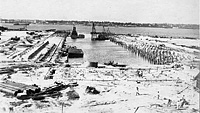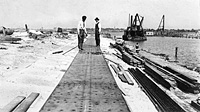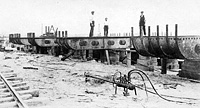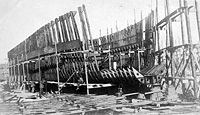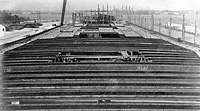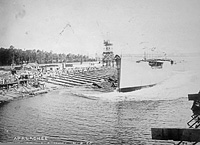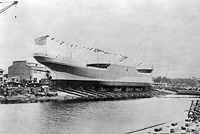EFC Design 1009 (McClelland type): Notes & Illustrations
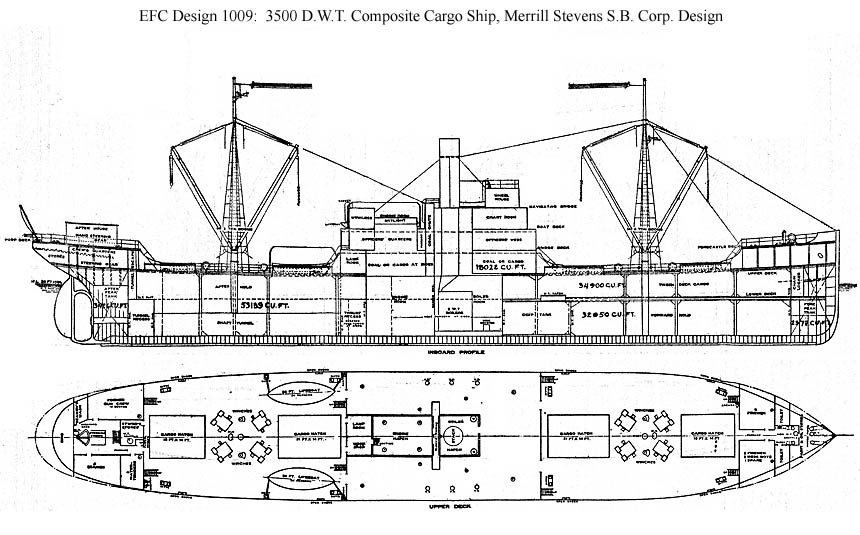
Click here for a larger and more complete plan from the 1920 USSB ship register: Sheet 1
Click on the photographs below to prompt larger views of the same images.
|
Notes: The origins of this design, the only composite one in the EFC program along with the nearly identical Design 1010, were recounted to a Senate committee by an officer of the Merrill-Stevens Shipbuilding Corp. at Jacksonville, Fla., on 22 January 1918. It began with a design produced by Merrill-Stevens before the war for composite tankers for an oil company of which another Merrill-Stevens official was an officer. At the time the price of steel plates was soaring and Merrill-Stevens opted to use a scheme developed by a yard in Chester, Pa., the "Jack system," in which cylindrical tanks were built to carry the oil and the ship was then built around them, all of steel except that the outside shell of the hull was made of wood planking instead of steel plates. The tanker design was about complete when war was declared against Germany and the government asked Merrill-Stevens for cargo ships. The firm hired Mr. N. E. McClelland, then of the American Bureau of Shipping, to modify their tanker design into a cargo ship that met ABS rules. The plans were completed before the EFC awarded Merrill-Stevens its contract No. 1 for twelve composite cargo ships on 29 April 1917. The ships were to be built at either Jacksonville, Fla., or Slidell, Ala.; in the event EFC hulls 1-4 along with four small steel ships (EFC hulls 13-16, Design 1012, contract No. 2) went to Jacksonville and hulls 5-12 went to Slidell. The design was approved by the EFC on 21 May 1917 and was also used by the Terry Shipbuilding Corp. at Savannah, Ga., (which had a contract for 20 composite ships and where McClelland later worked), and the Kelly-Atkinson Construction Co. (Mobile Shipbuilding Co.) of Mobile, Ala., which had a contract for 18 composite ships. The Terry and Kelly-Atkinson ships were designated Design 1010 although they were very similar to Merrill-Stevens's Design 1009. Work on the Design 1009 ships was interrupted in October 1917 when the EFC objected that the lines at the bow and stern were too full to reach the contract speed of ten knots, and the steel frames at the ends that had already been fabricated had to be straightened and re-bent. Hulls 9-12 at Slidell were cancelled when Merrill-Stevens got a contract on 9 May 1918 for five all-steel versions of Design 1009 at Jacksonville (EFC hulls 1555-59, Design 1073), which in turn were suspended on 5 November 1918 and cancelled on 2 May 1919. On 19 July 1918 Slidell got an order for six steel cylindrical oil carrying barges of 3300 dwt (EFC hulls 2499-2504, no design number), but these were cancelled on 12 March 1919. Specifications: Design 1009 (McClelland/Merrill-Stevens). Composite hull (steel frame). Deadweight tons: 3500 designed, 3575 actual. Dimensions: 284.5' oa, 270.0' pp x 46.0' ext, 45.0' mld x 24.25' depth mld, 21.25' draft load. Propulsion: 1 screw, 1 triple expansion engine, 2 Baden watertube boilers, 1400 IHP, 10 knots. Configuration: 2 decks, 2 holds, 4 hatches. |
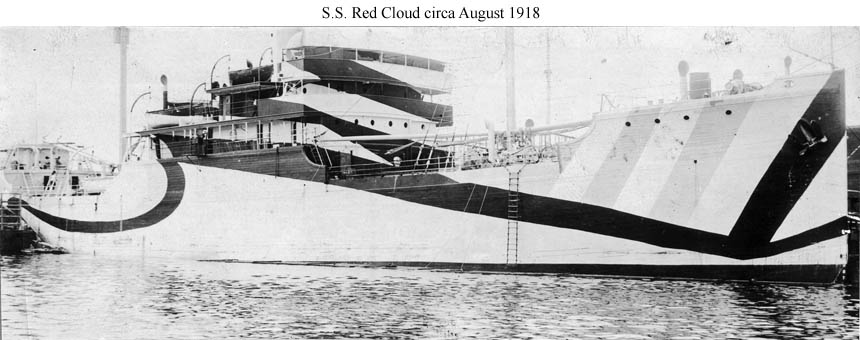
| S.S. Red Cloud (Design 1009, EFC Hull 1). This was the first of the four ships of this type built by the Merrill-Stevens S.B. Co. at Jacksonville, Fla. She is probably shown here around the time of her inspection by the Navy, which occurred on 28 August 1918. She was assigned the ID number 3371 and the photo was attached to her inspection report. (NHHC: SP/ID card) (Click photo to enlarge) |
